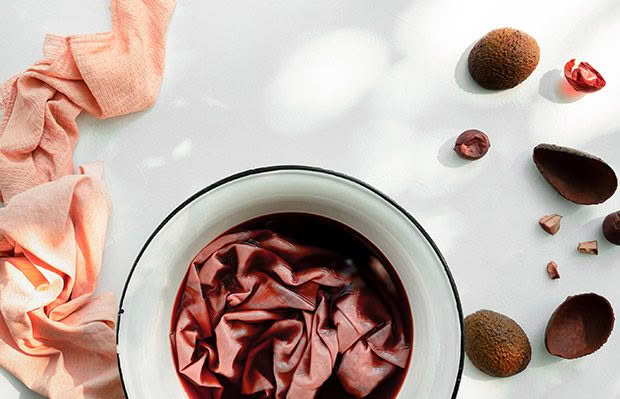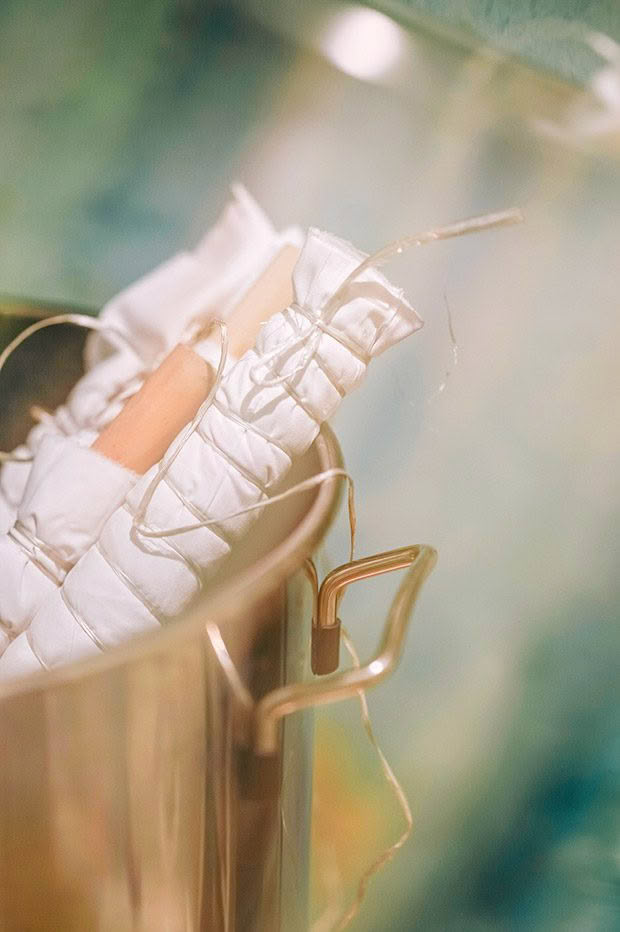DIY: How to make natural dyes from vegetables, fruit and pantry items

The pantry contains a smörgåsbord of ingredients perfect as natural dyes.
Extract from Nadia: A Seasonal Journal
From wild berries to cultivated flowers and fruits, nature offers many options for natural dyes. For thousands of years, craftspeople commonly used plants madder, woad and weld. Intense reds, blues and yellows were obtained from the roots or leaves, providing the primary colours for hundreds of different colours. The linen used to wrap Tutankhamun was dyed with madder, as were the jackets worn by British Army Redcoats from the mid-17th to 19th centuries. Specialist embroiderers – thought to be nuns – created the famous medieval Bayeux tapestry with woollen yarns dyed with madder, woad and weld.
If an item has colour, try using it to create a natural dye. Consider avocados, onions, turmeric, cabbages, berries, black tea and black beans — all are good for natural fabrics but have varying degrees of steadfastness.
Most dyes require a mordant. This is a metallic compound powder that helps colour adhere to the fabric available from hardware and craft stores. Alum powder is a common mordant and typically teamed with cream of tartar to help with evenness and brightness. If you want to avoid a mordant, choose foodstuffs naturally high in tannins (see the list below) – they hold their colour better. Beware, though, that without a mordant, the colour will fade more quickly.
Natural dyeing isn’t an exact art. Many things can alter the outcome, including the pH of the water, the temperature, and the variety of produce used (for example, different avocado varieties carry different pinks).
Fabric to use:
Natural dyes adhere best to natural fabrics. Choose pre-washed cotton, linen, silk or wool in white or a light colour. If your material or item of clothing has synthetic stitching, the thread won’t dye.
How to create your dye
Preparation:
Roughly chop your foodstuff, place it in a large saucepan and add enough water to cover by 5cm. Boil for 20 minutes to 1 hour to extract the dye. For example, avocado stones and skins need an hour; turmeric only 20 minutes.
If using roots or bark to dye, soak overnight, then boil for 1 hour. For black beans, soak in water overnight, then strain – the liquid is the dye. After boiling, leave to cool, then strain (put the foodstuffs in the compost), retaining the liquid for dyeing. There’s no need to strain the turmeric.
Dyeing the fabric:

Photo: Esther Bunning.
When ready to dye, first soak the fabric or yarn in clean water to open up the fibres, enabling the stain to penetrate evenly. Pour the liquid dye back into a saucepan and add more water if necessary so the fabric can move around freely. Add the fabric, bring to the boil and simmer for about 1 hour. Stir occasionally to ensure an even colour.
Once done, leave to cool slightly, then gently squeeze to remove excess dye. Hang outside in the shade to dry (sunlight accelerates fading). Use a pH-neutral soap when washing and cold- or low-temperature settings if using a washing machine.
PLANTS TO DYE FOR
Avocados. Avocado skins and stones make a pale pink or peach dye. For a deeper pink, use avocados with skins that are almost black with a pink tinge. Remove the flesh and leave the skins to dry. Once dry, store in a paper bag, or freeze, if necessary, until you have enough to use. Start first with 4 stones and 4 skins and see how you go.
Onion skins. Red onion skins provide colours ranging from pinky caramel to earthy brown, depending on how many skins are used and the type of fabric. For example, protein fibres (e.g. silk and wool) dye in a spectrum from pale to medium nutmeg brown. Cellulose fibres (such as cotton) will produce pale pinks. The skins of brown onions can produce the palest yellow to medium nutmeg.
Cabbage (red). Red cabbage produces a purple shade, but changing the pH of the water, results in different colours. For purple, use water. If you want a pinker shade, add vinegar. For blues and greens, add baking soda. Experiment with the quantities for different shades.
Berries. Use any berry – blueberry, raspberry, blackberry, boysenberry. Start with 1 cup of berries and add more for deeper shades.
Beetroot. If pink is your thing, then beetroot is your friend. You can obtain hues from dusty pink to vibrant pink, depending on how many roots used and how long the fabric is left to soak.
Black beans. Black beans produce beautiful shades of blue. Use dried beans – available from wholefood and speciality stores – or grow your own. Don’t throw away the beans after soaking them – they can be cooked and eaten.
Black tea. For warm brown shades, use black tea. It’s easiest to use teabags as the dye won’t require straining. Use 3-5 teabags – or more for a deeper shade.
Turmeric. Depending on the intensity you require, add ¼ to ¾ cup of turmeric powder to a saucepan of water to make pale to vibrant yellows.
Walnuts. The English walnut’s green husks and shells create a light to dark brown colour, the leaves a creamy fawn.
 This article first appeared in Nadia: A Seasonal Journal Magazine.
This article first appeared in Nadia: A Seasonal Journal Magazine.

